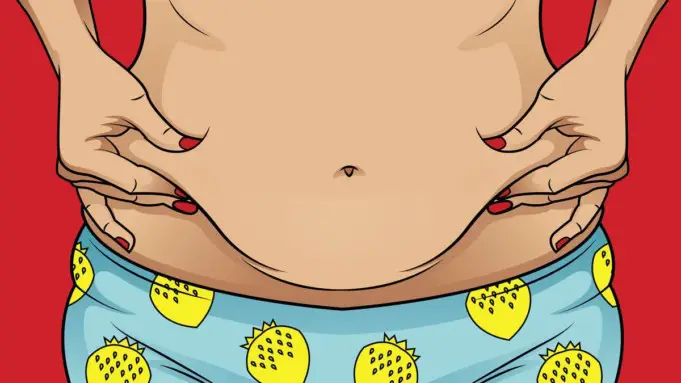We may all have belly fat, but there are different types of belly fat, and knowing the type of belly fat one has would help in losing it. All belly fats are not the same.
There are different types of belly fat, and their causes vary. Also, the treatment or the way to lose the different types of belly fat varies.
A woman may put on excess fat around the belly due to stress, motherhood (pregnancy and after birth), hormones, bad or unhealthy eating habits, sedentary lifestyle.
Belly fat is excess abdominal fat surrounding the organs in the stomach. Belly fat simply refers to fat around the abdomen (that is, the belly).
When a person gains excessive weight, the body starts to store fat in unusual places such as the stomach area, that is, the belly.
When the body is unable to process the sugars into energy, the person ends up with fat.
Fat is required for the body to function properly, as it is the source of energy, but when the body cannot burn the same effect, that’s when one ends up with belly fat.
But this does not mean that belly fat is gotten only by weight gain. One can have belly fat even without gaining weight as there are other causes of belly fat, depending on the type of belly fat.
Research has indicated that the natural aging process, hormonal ups and downs, excess intake of sugar and trans-fat, and sedentary lifestyle are all possible causes of belly fat.
The types of Belly fat include:
1. Mommy’s belly fat
This type of belly fat is common to women who have just been put to bed. It can be referred to as Post-Pregnancy weight.
During pregnancy, the woman’s body builds up fat to protect the fetus. After the baby is born, the mother might have some loose skin and extra fat beneath the waistline from muscles that stretched during pregnancy.
A mommy’s belly falls low, below the actual waistline. All that fat that a woman’s body accumulated to ensure the safe delivery of a healthy baby tends to hang loose after the baby is delivered.
Mommy’s belly fat is also a result of the stretching of the muscles that happens when carrying the pregnancy. One might even feel a gap between the upper abdomen’s stomach muscles, which also feels loose.
How to fix Mommy’s Belly Fat?
It is advised that a woman who just gave birth should wait a month or so after delivery, then begin regular belly workouts to lose this type of belly fat. Workout exercises such as Leg lifts, Forearm plank, Reverse crunch, scissors kicks are a great way to strengthen and tighten the belly.
Breastfeeding: If she (a woman who just delivered) is breastfeeding, then it is good news. Breastfeeding is not only about feeding and cuddling the baby – it may also help the mother lose weight and belly fat in the process.
Research has shown that breastfeeding mothers use about 400 to 500 calories daily to make the complete amount of milk that most babies need, from birth to 6 months. As such, mothers who breastfeed exclusively for more than three months tend to lose weight more than those who don’t.
Also, a mother is motivated to eat healthy foods when breastfeeding so the baby can get all the nutrients from breast milk.
2. Stressed-out belly fat
As the name implies, this type of belly fat is a result of stress. Lack of enough rest and sleep, fatigue, and exhaustion are causes of stressed-out belly fat. Metabolism is slowed down due to stress and exhaustion, and fat begins to settle in the upper abdomen.
If your upper belly (just below the ribs) is expanded and bulges out when you sit or wear your shirts, or your upper belly spills over your shorts or protrudes when you sit, you may have Stressed-Out Belly Fat.
Having a sensation of discomfort and even breathlessness after a tiring day are symptoms of Stressed-Out Belly Fat.
How to fix Stressed-Out Belly Fat?
Since this type of belly fat is caused by the stressful life one leads and lack of proper sleep at night, to fix it, the following should be done
Start sleeping at the right time and follow healthy sleeping habits, including switching off from your emails and phone at least half an hour before you hit the bed.
Exercise the body – You can do low-impact yoga stretches to get your body to relax. It also helps you digest your food.
Eat a little early at night so that you are not discomfited by the digestion process. Avoid caffeine at night.
3. Hormonal belly fat
According to its name, this type of belly fat is a result of Hormonal Imbalances or Hormonal Disorder. Sometimes, excess fat around the belly is due to hormones.
Hormones help regulate many bodily functions, including metabolism, hunger, sex drive, and even stress. If a person has a deficiency in certain hormones, it may result in weight gain around the abdomen, which is known as hormonal belly fat.
Rapid weight gain around your lower belly, especially around your pelvic area, is a sign of belly fat triggered by hormonal imbalances. Several women suffer from PCOS (Polycystic Ovary Syndrome), which might also result in the lower belly extending out and falling low.
This weight gain occurs without warning and for no obvious reason.
How to fix Hormonal Belly Fat?
A person who has Hormonal Belly Fat should endeavor to consult a gynecologist to find out if it is caused by PCOS or other feminine hormonal issues. Get treatment for the same.
Treatment for Hormonal Belly Fat include;
Healthy Diet: A person that has Hormonal Belly Fat should try eating lean proteins like fish and chicken, along with cruciferous green vegetables, which are also high in fiber.
Antioxidant food like tomatoes and oranges should improve your body’s immunity. Try healthy juices and smoothies.
Regular exercise: Include exercises that work on the lower belly, along with hip raise to tone the lower belly area.
Take Medications that would help balance hormones. These medications must be prescribed by a doctor.
Reducing stress, adequate rest, and enough sleep at night may also help to fix Hormonal Belly Fat, as these may help in hormonal balance.
4. Tiered Belly Fat
How to fix Tiered Belly Fat?
Since his sedentary lifestyle and poor eating habits, especially alcohol and smoking, are to blame for his belly fat, he can address it by:
- Eating balanced foods: If you want to lose belly fat, say goodbye to those French fries and bags of salted chips. Include a moderate-intensity workout in your everyday routine. Choose whole-grain cereals such as oats and brown rice, as well as lean proteins such as eggs and fish, as well as vegetables. This form of belly fat is the most difficult to lose; progress can be sluggish but persevere.
- Reduce alcohol consumption.
- Regular exercise can also assist in the removal of tiers of abdominal fat.
5. Bloated belly fat
With a rise in the average girth of your belly, your stomach becomes distended. You get a sudden sense of being incredibly stuffed.
There is a feeling of constriction in the stomach. Your stomach appears to be perfectly round and stretched in front of you.
What you can do is;
This isn’t so much due to fat as it is due to a digestive condition. You might feel bloated after eating those foods.
It follows a cyclic pattern in which your stomach can be normal in the morning but increases in size as the day goes on.
Simply eat a well-balanced diet rich in foods and herbs that help and control digestion, and avoid foods like dairy and gluten that may be causing or exacerbating the issue.
What should you do about belly fat in general

When you notice that your belly fat is growing, the first thing you can do is find out what’s causing it. Any of the types of belly fat listed above could be the cause.
This is significant because people gain weight in a variety of ways and for a variety of reasons. After the cause has been ascertained, the appropriate means of losing belly fat, depending on the type of belly fat, should be adopted.
Generally, there are ways to combat Belly Fat. They include: Regular exercise, Eating Healthy Foods/Dieting, a Healthy lifestyle, Engaging in activities, or taking medications that would help to balance the hormones. If you’re unsure if fat burning pills are right for you, contact your primary care provider
Reference;
- Types of belly fat and how to get rid of them; her.womenworking.com
- Types of Belly Fat; Fittrimhappy.com
- How to Manage Different Types of Belly Fat in Women; Possible.












